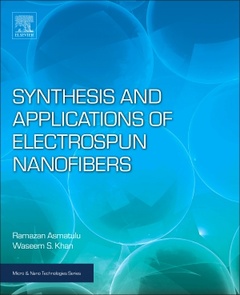Description
Synthesis and Applications of Electrospun Nanofibers
Micro and Nano Technologies Series
Authors: Asmatulu Ramazan, Khan Waseem S.
Language: English
Subjects for Synthesis and Applications of Electrospun Nanofibers:
Keywords
Agricultural and food applications; Antibacterial agent; Antibacterial nanofiber mats; Applications of nanofibers; Battery membranes; Biosensor; Conventional fiber-forming techniques; Dental regeneration; Differential scanning calorimetry; Disease control and prevention; Drug loading; Drug release rate; Dry filtration; Early detection of sickness; Electrically and thermally conductive nanofibers; Electrospinning; Electrospun nanofibers; Electrospun nanofilter technology; Energy conversion; Filtration and separation of beverages and oils; Fire retardancy; Forcespinning; Fuel cells; Hard and soft tissues; Historical background; Hydrogen energy; Hydrogen storage; Light and noise absorptions; Lithium-ion batteries; Localized treatments; Magnetic nanofibers; Membrane science and technology; Metamaterials; Nanofiber fabrication; Nanofibers; Nanomedicine; Nanosafety; Nanosensor; Nanotechnology; Optical spectroscopy; Optoelectronics; Organic chromophores and bio-chromophores; Oxidative stress; Packaging industry; Particle size; Photocatalyst; Photonic and light-emitting; Physical and chemical properties; Process and system parameters of electrospinning; Protection; Protective clothes; Protective clothing; Scaffolds; Selectivity; Sensitivity; Sensors; Separation; Solar cells; Solar energy; Structural characterization; Supercapacitors; Surface charge and area; Surface chemistry; Surface superhydrophobicity; Tissue engineering; Toxicity; UV-vis spectroscopy; Water splitting; Water treatment; Wet filtration; Wound dressing; Woven and nonwoven fibers; X-ray diffraction
177.10 €
In Print (Delivery period: 14 days).
Add to cart306 p. · 19x23.3 cm · Paperback
Description
/li>Contents
/li>Readership
/li>Biography
/li>Comment
/li>
Synthesis and Applications of Electrospun Nanofibers examines processing techniques for nanofibers and their applications in a variety of industry sectors, including energy, agriculture and biomedicine. The book gives readers a thorough understanding of both electrospinning and interfacial polymerization techniques for their production. In addition, the book explore the use of nanofibers in a variety of industry sectors, with particular attention given to nanofibers in medicine, such as in drug and gene delivery, artificial blood vessels, artificial organs and medical facemasks, and in energy and environmental applications.
Specific topics of note include fuel cells, lithium ion batteries, solar cells, supercapacitors, energy storage materials, sensors, filtration materials, protective clothing, catalysis and electromagnetic shielding. This book will serve as an important reference resource for materials scientists, engineers and biomedical scientists who want to learn more on the uses of nanofibers.
1. Introduction to electrospun nanofibers2. Historical background of the electrospinning process3. Electrospun nanofibers for drug delivery4. Electrospun nanofibers for textiles5. Electrospun nanofibers for agriculture and food industries6. Electrospun nanofibers for energy applications7. Electrospun nanofibers for filtration applications8. Electrospun nanofibers for catalyst applications9. Electrospun nanofibers for nanosensor and biosensor applications10. Toxicity of nanofibers and recent developments in protections11. Electrospun nanofibers for tissue engineering12. Electrospun nanofibers for photonics and electronics applications13. Characterization of electrospun nanofibers
Materials scientists, engineers and biomedical scientists who want to learn more about how nanofibers are produced, and how they are used
Dr. Waseem S. Khan conducted his postdoc research at the Wichita State University, Wichita, Kansas, USA. He joined Majmaah University, Majmaah, Saudi Arab, in 2014 and worked there as Assistant Professor in the department of Mechanical and Industrial Engineering for three years. He later joined Dubai Men’s College, Higher Colleges of Technology, Dubai, United Arab Emirates, in 2017. He has been working there an Assistant Professor, since 2017. Throughout, his studies he published more than 30 journal papers, 40 conference papers and 20 book chapters. He received several awards in Saudi Arab and Dubai. He received more than $100,000.00 internal and external grants from different sources.
- Describes a variety of techniques for producing nanofibers
- Shows how nanofibers are used in a range of industrial sectors, including illustrative case studies
- Discusses the pros and cons of using different fabrication techniques to produce nanofibers
These books may interest you

Electrospun Nanofibers 264.10 €



